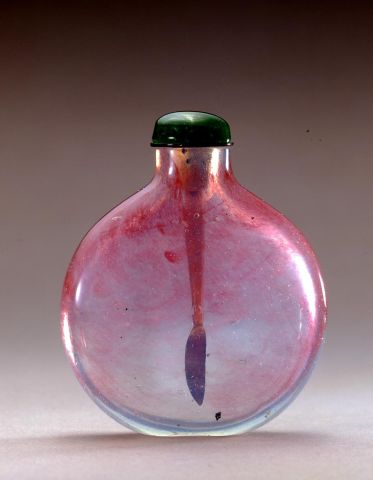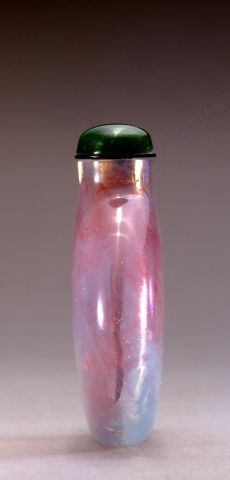

Bottle ID: 00366
PINK ROSY, SPLASHES & SWIRLS FADING TO A CLEAR BASE
Date: 1744-1795
Height: 56 mm
Glass, of flattened rounded form with a flat base, of translucent rosy-pink splashes and swirls thinning to clear opalescent tones towards the base.
Imperial, attributed to the Palace Workshops, Beijing.
Similar Examples:
Brody, Alexander. Old Wine into Old Bottles: A Collector's Commonplace Book, 1993, pp. 80-81.
Hui, Humphrey K. F., Margaret Polak and Christopher C. H. Sin. Hidden Treasures of the Dragon - Chinese Snuff Bottles from the Collections of Humphrey K. F. Hui, Margaret Polak, and Christopher C. H. Sin, 1991, pp. 118-119, no. 237.
Christie's, New York, March 21, 2002, lot 9, The Blanche B. Exstein Collection.
Provenance:
Clare Lawrence Ltd.
Sotheby's, New York, September 15, 1998, lot 63
Neal W. and Frances R. Hunter
Mr. and Mrs. Edgar S. Wise
Purchased in Beijing, China 1920-1924 [by repute]
Exhibited:
Annual Convention ICSBS Toronto, October 2007
A number of small glass objects exist in the Palace collections manufactured from this slightly opalescent swirly rosy-pink glass. Both the opalescent glass and the pink colors are listed in the Palace Archives during the Qianlong period with three colors of 'white' listed: transparent, opaque white and clair de lune and pink, from 1744 onwards. The Palace Archives also confirmed that there were two official names of the glass works - the bolichang (glass factory) and the bolizuo (glass workshop), both of which were listed in two entries together with one of the entries specifically relating to snuff bottles. The original Imperial glass factory (the bolichang) was built in 1696, along with all the other workshops, with the exception of the one for porcelain which was located at Jingdezhen within the confines of the Palace. Recent research indicates that this glasshouse was retained on the Catholic compound to the west of the Church, and was from then on referred to as the Glass Factory. During the reign of Yongzheng, another glasshouse was built at the Summer Palace, the Yuanming Yuan, where it remained until the end of the Qing dynasty, and this was referred to as the Glass Workshop. At the bolichang, glass furnaces were still used to manufacture the objects; while it seems likely that at the bolizuo, grinding and polishing was the order of the day to produce or finish wares of a higher quality.
This glass example would have been produced by blowing the initial opalescent glass into a mold and then trailing thin canes or frits of pink glass onto the body and reworking the bottle so that the pink swirls fused into the opalescent body. It would subsequently have been shaped and polished.
< Back to full list

 English
English 中文
中文